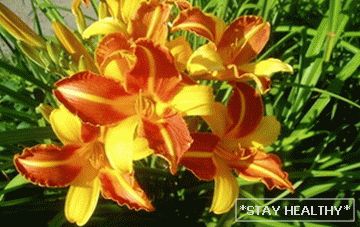 Mon, Mar 07, 2016
Mon, Mar 07, 2016
The genus of the daylily (Hemerocallis) of the daylily family
represented by about 25 species, which are considered the birthplace of the eastern
Asia and Europe. Лилейники являются роскошными
perennial plants that can be the decoration of any garden
shining cheerful colors of their large flowers that can
reach 5-20 cm. At the same time can be revealed from 1 to 3
flowers, and the duration of flowering of one bush can be
up to 30 days.
All natural types of daylilies are distinguished by their beauty and grace.
In the decorative gardening often prefer
daylily red, yellow, small, Dumore, Middendorf,
lemon yellow. Natural daylily species are not characterized
only beauty, but also reliability, disease resistance and
pests and longevity.
Contents
Daylily – growing and care
Daylilies – plants, very unpretentious in the care. But still,
it’s better to choose nutrient-rich plantations for them
humus soils. Heavy clay soils will contribute
stagnation of moisture and the development of fungal diseases, and on sandy soils
plants will not be sufficiently supplied with water and
nutrients.
Abundantly and continuously daylilies can only bloom at
plenty of sunshine. When it is cloudy, they are generally generally
do not open, and if summer is cold, then flowers
grow smaller, and the plant may stop flowering.
These plants are tough thanks to their powerful
a root system that allows water to come from a great depth,
therefore, they do not like frequent irrigation, especially surface watering.
the time which water drops falling on the flowers can damage them
petals. Watering daylilies should only be a long drought,
and it should be done at the root.
In the spring, during the beginning of the growing season, daylilies
fed with full complex mineral fertilizer. Him
should be scattered between the bushes, and then water the plant to
ensure fast and high-quality assimilation of fertilizers. In a month
after flowering, at the onset of a short period of rest of the plant
before the start of the new growth and budding of the next year, its
should feed again. This feeding will increase
daylily size and get the maximum number of flowers in the next
season.
During flowering, regularly pluck withered flowers,
so that the plant does not waste their resources on them. After
the end of flowering is necessary to cut off the flower shoots, and before
wintering – the entire aboveground part. Daylilies react very positively
on soil mulching between bushes, wood chips, crushed
bark or dry peat (but not fresh sawdust).
In winter, these plants have a rest period. Spring right away
after the convergence of snow, you need to cut dry leaves. When
the earth warms up a bit, you can start the division too
overgrown or old plants.
Лилейник – пересадка и breeding
Without a transplant, daylilies can live for many years.
It is best to plant them in May or August. If necessary, you can
transplanting plants and in the gap between these months, but
This should be done in cool weather. Later August not plant them
It is recommended, as they may not have time to take root and die in
winter cold.
The distance between daylilies during planting should be from 60
up to 100 cm, as they, growing up, expand greatly, and when
close accommodations will not have room for free
accommodation in the flower garden.
If there are good garden soils at the site, then just
a hole dug 30 cm deep, where a mix is poured by a mound,
which includes humus, sand and peat with an additive
potassium phosphate fertilizer, ash and superphosphate. On poor or
heavy soil planting pit is filled with a nutrient mixture. Then
bush intended for planting, you need to shake off the ground and
wash with water to examine the roots for their condition, availability
diseases and pests. By cutting old, dry,
damaged roots, their cuts sprinkled with ashes, and lower the plant
into the hole, gently spreading the roots on the surface of the hill.
Pouring on top of the nutrient mixture, the plant is watered abundantly and
properly compressed roots. Root neck when planting need 2 cm
grind dry humus or peat.
Daylilies are propagated in a vegetative way with seeds. With
vegetative propagation using young bushes, whose age
no more than 5-6 years. They should be carefully separated by hand or knife
taking care not to damage the fragile roots and rosettes of leaves at the base.
It is best to engage in the division of the bush in the spring, so how if
this later, the daylily this year may not bloom.
Seeds that quickly lose their germination are best sown.
freshly collected under the winter to a depth of 2 cm. However, they can
sow and spring of next year. Plants that are grown
from seeds, usually bloom for 2-3 years.
Daylily – diseases and pests
The most dangerous of daylily diseases is root rot.
cervix which can lead to the death of the plant. Withчиной ее
The appearance is usually a waterlogging of the soil. Learn disease
can be on the yellow color of young foliage and its softness. With
detecting signs of damage to rot root collar plant
excavated and, cutting out damaged tissue with a sharp knife, washed
cuts with potassium permanganate solution. After этого, просушив лилейник на
air, it is planted in another place.
Daylily can be affected by such a dangerous pest, like a mosquito
daylilies, the larvae of which gnaw the flower buds. Because of this
their deformation occurs, the plant loses its decorative effect.
Usually, damaged buds are simply gently removed.
Thus, daylilies need some attention, but the trouble
they deliver a little, and even a novice gardener without difficulty
will hold all the necessary activities that will help support
plants are healthy and capable of abundant flowering.





